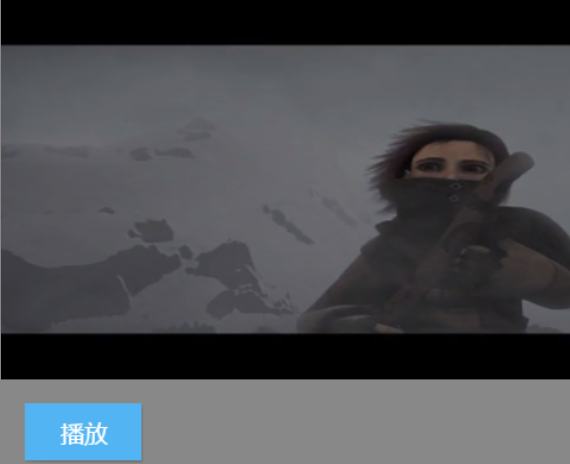视频
在 Egret 中,可通过egret.Video来创建和管理视频。
需要注意的是,大部分移动设备只支持全屏播放。
1.准备工作
W3C 提供了在线地址来测试 HTML5 的视频功能。地址为:static/file/trailer.mp4。
下面的代码将使用这个视频作为素材。代码中需要一些 UI 的元素,所以使用默认的 EUI 项目。
可以通过:
egret create VideoTest --type eui
来创建默认的 EUI 项目。更多关于使用 EUI 方法参考:EUI库 快速入门
2.使用方法
2.1.创建视频
创建Video的代码如下:
class VideoTest extends egret.DisplayObjectContainer {public constructor() {super();this.video = new egret.Video();this.video.x = 0; //设置视频坐标xthis.video.y = 0; //设置视频坐标ythis.video.width = 640; //设置视频宽this.video.height = 320; //设置视频高this.video.fullscreen = false; //设置是否全屏(暂不支持移动设备)this.video.poster = "resource/assets/Button/button_up.png"; //设置loding图this.video.load("static/file/trailer.mp4");this.addChild(this.video); //将视频添加到舞台//监听视频加载完成this.video.once(egret.Event.COMPLETE, this.onLoad, this);//监听视频加载失败this.video.once(egret.IOErrorEvent.IO_ERROR, this.onLoadErr, this);}private video: egret.Video;private onLoad(e: egret.Event) {const btnPlay: eui.Button = new eui.Button(); //新建播放按钮btnPlay.label = "播放";btnPlay.x = this.video.x + 20;btnPlay.y = this.video.y + this.video.height + 20;this.addChild(btnPlay);//监听按钮行为,当按下时调用播放函数。btnPlay.addEventListener(egret.TouchEvent.TOUCH_TAP, this.play, this);//获取视频长度console.log(this.video.length);}private onLoadErr(e: egret.Event) {console.log("video load error happened");}public play(e: egret.TouchEvent) {this.video.play();}}
这里需要注意的是在 EUI 默认项目的入口文件类里面需要实例化上面的VideoTest,并删除默认的 UI。代码如下:
class Main extends eui.UILayer {protected createChildren(): void {super.createChildren();const theme = new eui.Theme("resource/default.thm.json", this.stage);this.addChild(new VideoTest());}}
编译并运行我们可以看到如下的效果:

注意: 在大多数移动设备中,视频是强制全屏播放的。当在手机上点击播放时会弹出全屏的播放器。而上面的代码在PC上将按照我们的设定不会全屏播放。
在上述代码中,首先设置了视频的宽高和位置。 egret.Video类同样继承自DisplayObject,所以可以操作其的位置宽高和touchEnable属性等。同样也需要加到显示列表当中才能被显示出来。
然后设置了poster 属性为本地的一张图片,poster表示视频加载前,或者在不支持将 video 画在 canvas 的设备上,想要显示的视频截图地址,也就是下面的截图。

之后通过load方法载入了视频的地址,然后监听加载完成和失败的事件。
需要注意的是视频需要加载完成再调用
play()方法。
这里当视频加载完成之后添加一个播放按键,当点击时播放该视频。
这里视频的play()方法有两个参数,为播放的位置和是否循环。默认的从头开始播放,并且不循环。
2.2.暂停视频
通过Video的pause()方法将暂停视频。
继续完善上面的程序,添加暂停按钮的功能。在onLoad函数中,绘制一个暂停的按钮,并监听其行为:
//在onLoad函数中添加暂停按钮const btnPause: eui.Button = new eui.Button();btnPause.label = "暂停";btnPause.x = btnPlay.x + btnPlay.width + 20;btnPause.y = btnPlay.y;this.addChild(btnPause);btnPause.addEventListener(egret.TouchEvent.TOUCH_TAP, this.pause, this);
然后在VideoTest类中添加暂停视频函数:
class VideoTest {private pause(e: egret.TouchEvent) {this.video.pause(); //暂停视频}}
点击该按钮视频将暂停播放,再一次点击播放按钮视频将继续播放。
2.3.设置音量
通过设置Video的volume属性可以设置其音量的大小。其属性值为0到1。
下面通过 EUI 的水平滑块来控制。同样在onLoad函数中添加如下代码:
//设置控制音量的滑块,监听它的CHANGE事件,当滑动滑块时回调 `setVoluem()` 函数。const volume: eui.HSlider = new eui.HSlider();volume.x = btnPlay.x;volume.y = btnPlay.y + btnPlay.height + 20;this.addChild(volume);volume.value = 100;volume.maximum = 100;volume.minimum = 0;volume.width = 200;volume.addEventListener(egret.Event.CHANGE, this.setVoluem, this);
然后在VideoTest类中添加设置音量的函数:
class VideoTest {private setVoluem(e: egret.TouchEvent) {this.video.volume = e.target.value / 100;}}
这里滑块设置的最大值和最小值是0和100,由于volume的默认值为0到1,所以要除以100.
2.4.全屏播放
只有在桌面浏览器上才能控制非全屏的效果。通过设置fullscreen属性来控制是否全屏。默认值为true,即全屏播放。
同样在onLoad函数中添加如下代码:
//设置全屏播放开关按钮const screenSwitcher: eui.ToggleSwitch = new eui.ToggleSwitch();screenSwitcher.label = "全屏";screenSwitcher.x = btnPause.x + btnPause.width + 20;screenSwitcher.y = btnPause.y;screenSwitcher.addEventListener(egret.Event.CHANGE, this.setFullScreen, this);this.addChild(screenSwitcher);
然后在VideoTest类中添加设置是否全屏显示的函数:
class VideoTest {private setFullScreen(e: egret.TouchEvent) {//当开关被选择后。该开关的selected属性将变为true,反之则为falsethis.video.fullscreen = e.target.selected;}}
2.5.显示播放时间
Video的position属性表示视频文件中当前播放的位置(以秒为单位)。
同样在onLoad函数中添加如下代码,用来显示播放时间。
//使用label标签来显示文字,并监听`ENTER_FRAME`事件来更新显示。const position: eui.Label = new eui.Label();position.x = btnPlay.x;position.y = volume.y + volume.height + 20;this.addChild(position);position.addEventListener(egret.Event.ENTER_FRAME, this.showPosition, this);
然后在VideoTest类中添加显示播放时间的函数:
class VideoTest {private showPosition(e: egret.TouchEvent) {//当开关被选择后。该开关的selected属性将变为true,反之则为falsee.target.text = "播放时间: " + this.video.position;}}
2.6.获取视频的bitmapData
通过视频的bitmapData属性可以获得其当前帧的纹理信息。可以将它绘制到舞台上。
在onLoad函数中添加截图的按钮,点击该按钮将在舞台上添加一张截图:
const btnPrintScreen: eui.Button = new eui.Button();btnPrintScreen.label = "截图";btnPrintScreen.x = screenSwitcher.x + screenSwitcher.width + 40;btnPrintScreen.y = btnPlay.y;this.addChild(btnPrintScreen);btnPrintScreen.addEventListener(egret.TouchEvent.TOUCH_TAP, this.printScreen, this);
然后在VideoTest类中添加截图的函数:
class VideoTest {private printScreen(e: egret.TouchEvent) {const bitmap: egret.Bitmap = new egret.Bitmap();bitmap.bitmapData = this.video.bitmapData;bitmap.x = this.video.x;bitmap.y = this.video.y + this.video.height + 150;this.addChild(bitmap);}}
这里创建了一个位图,并将它的bitmapData属性设置为视频的bitmapData属性。将该位图添加到舞台上面就可以显示截图了。
2.7.获取视频长度
Video的 length 属性可以获得视频的长度。
//获取视频长度console.log(this.video.length);